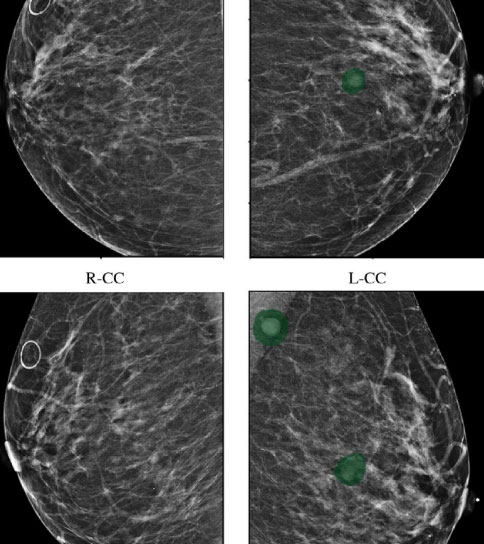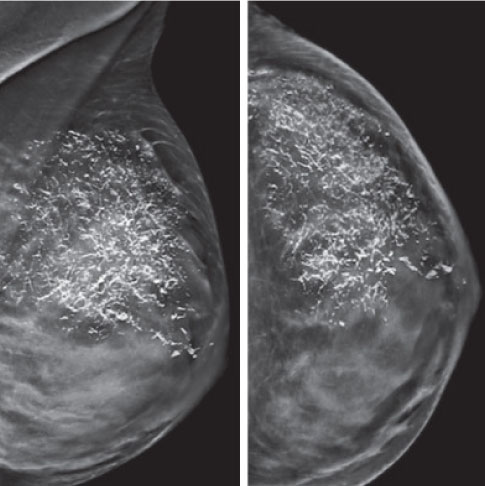Mammography

What is
Mammography ?
A mammogram screening is a safe, low-dose X-ray picture of the breast where two X-ray pictures of each breast are taken.
About Mammography Diagnosis
Breast cancer is the most common cancer in women today due to changing lifestyles, but the good news is that if detected early, it has a 90% cure rate. Mammography diagnostic is the most reliable method for detecting early and small breast cancer.
Routine screening can decrease the mortality rate by 30-35%. It can also increase the chances of breast conservation surgery. If detected early, breast cancer is curable.
Why Mammography Test Is Done?
For women at average breast cancer risk.
- Women between 40 & 44 yrs have the option to start screening with a Mammogram every year.
- Women between 45 to 54 yrs should get a Mammogram every year.
- Women 55 yrs & older can switch to a mammogram every other year or they can choose to continue yearly Mammograms. Screening should continue as long as a woman is in good health & is expected to live at least for 10 more years.
- Clinical breast examinations are not recommended for breast cancer screening among average-risk women at any age.
For women at high risk for breast cancer
Mammography for Breast Cancer: They should do a Mammogram screening every year starting from 30 yrs of age. Examination by a physician is recommended every 3 yrs.
What are the high-risk factors?
- Personal history of breast cancer.
- Strong family history of breast cancer.
- Have a known BRCA1 or BRCA 2 gene mutation. (based on having had genetic testing)
- Have a first-degree relative (parent, brother, sister or child) with a BRCA 1 or BRCA 2 gene mutation & have not had genetic testing themselves.
- Had radiation therapy to the chest when they were between the ages of 10 & 30 yrs.
- Have Li-Fraumeni syndrome, Cowden syndrome or Bannayan-Riley-Ruvalcaba syndrome or have first degree relatives with one of these syndromes.
- Never had children or had first childbirth after the age of 30 yrs.
- Early-onset of menses. (before the age of 12 yrs)
- Late-onset of menopause. (after the age of 55 yrs)


What is Diagnostic Mammography?
Any woman having symptoms of breast disease, i.e. lump, pain, discharge, nipple retraction or skin texture/colour changes should undergo a mammogram screening. Mammography can help to decide whether a lump is benign or malignant and can be a guide for biopsy.

Mammography Services Preparations & Procedures
How is mammography performed?
In our mammography section, mammography is performed by a specially trained female radiology technologist. The breast is compressed between two plates attached to a specially designed X-ray machine. This may cause some discomfort but it is a relatively painless procedure. Compression lasts only for a few seconds and the entire procedure of mammography takes about 20 minutes. The technologist will guide you throughout the procedure and will answer all your queries.
What preparation are necessary for mammogram
- Mammography should ideally be done 3 to 5 days after the menstrual period. On the day of examination, a woman should not use perfume, talcum powder oR deodorants in the underarm of the breast area.
- It is advisable to wear loose clothing.
- When should mammography not be done?
- Women under the age of 30 years, unless indicated by the doctor.
- Pregnant and lactating woman.
- The unique features of our mammography section: Ours is a dedicated state of the art machine.
- A low dose of radiation, high resolution with superior image quality, AEC (automatic exposure control) and optimized compression with automatic decompression are the unique features of our machine.
- Highly trained Radiologists and Technologists (all-female professionals) involved with mammography work.
- Correlation with ultrasound is performed for all patients for perfect diagnosis. In doubtful cases, clinical and pathological correlation is done in consultation with a Gynaecologist, Surgeon and Pathologist.
- Mammographically guides procedures like FNAC, Core Biopsies.
A MAMMOGRAM FINDS BREAST CANCER YEARS BEFORE YOU CAN EVEN FEEL IT, IF DIAGNOSED IN TIME, BREAST CANCER IS CURABLE!
How to examine your breast?
Breast self-examination (BSE) is a simple skill that may save your life! As implied BSE is done by women themselves, BSE should be performed each month at the same time about a week after the start of your period. Familiarity with the usual appearance and feel of one’s breast is important to notice any change such as a lump or thickening. Early discovery of a change from what is normal can be detected by BSE as early discovery increases the chances of cure. All women from the age of 20 should do regular BSE.
How to do BSE (Breast Self-Examination)?
- Look at your breasts in the mirror. Look for any change in size or shape, retraction of nipple, dimple or thickening of the skin or any obvious lump.
- Raising both your arms, look for any asymmetry in your breasts.
- Keep your hands around your waist and press them firmly. These positions may help in showing any retraction or dimpling present over the skin of the breast.
- Lie down with one of your arms stretched behind your head. Examine your left breast with your right hand and vice versa as shown in the picture. While palpating keep fingers close to each other, use the flat surface of the fingers to feel for any lumps in the breast. Do not feel the breast between the fingertips and the thumb. Press firmly enough to know how your breast feels. A firm ridge at the lower curve of each breast is normal.
- Feel the whole breast in a systematic manner. The breast is divided into 5 parts, the upper inner area, lower inner area, upper outer, lower outer area and the central area beneath the nipple. Feel all the parts of the breast without missing any area.
- In the same manner examine the other breast. If you find any changes, see your doctor right away. Lumps need to be investigated further.
If you find any change in your breast, do not panic, seek your consultant’s advice immediately. Remember BSE (Breast Self-Examination) is not a substitute for regular mammograms or regular examination by a doctor.
